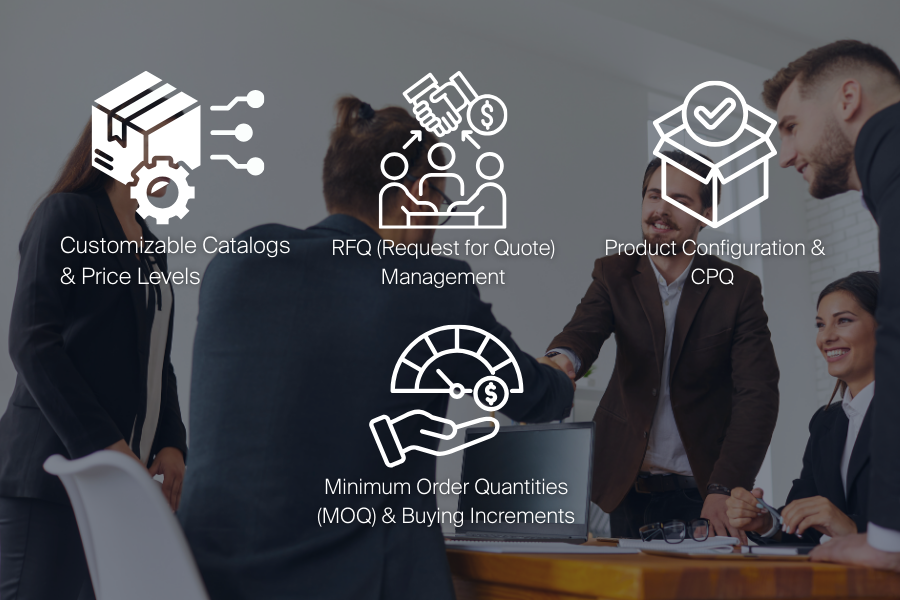B2B commerce isn’t just changing—it’s sprinting toward a digital-first future. By 2025, 80% of B2B sales interactions will happen online (Gartner). If your platform can’t keep up, your competitors will gladly take your place.
Choosing the right B2B commerce platform isn’t about bells and whistles; it’s about scalability, seamless integrations, and AI-driven efficiency. Buyers expect multi-storefronts, custom pricing, and automated procurement—not clunky systems that slow them down. And if your platform can’t scale with demand, success quickly turns into a bottleneck.
This isn’t another list of features. It’s your B2B eCommerce survival guide—a no-nonsense checklist for selecting a platform that won’t just support your business today but will power its growth for years to come. Because in this market, the wrong choice isn’t just inconvenient—it’s a competitive advantage handed to someone else.

Scalability & Performance: Supporting Business Growth Across Borders
Scalability in B2B eCommerce isn’t optional—it’s the backbone of sustainable growth. With global B2B eCommerce sales expected to reach $18.97 trillion by 2028 (Grand View Research), businesses need platforms that expand effortlessly across markets, currencies, and sales channels.
Key Scalability Features:
- Global Tool-Kit: Automates multi-country tax calculations, supports multiple currencies, payment methods, and localized pricing. No more checkout headaches for international buyers.
- Multi-Storefront Capabilities: Manage multiple brands, regions, or B2B segments from a single backend, avoiding the chaos of juggling multiple platforms.
- Hybrid Sales Channels: Enable seamless transactions via EDI, PunchOut Catalogs, WhatsApp, Email, Slack, and Trade Portals to meet buyers where they are.
- Bulk Ordering & Multi-Basket Support: Allow CSV uploads, pre-saved carts, and bulk discounts for high-volume B2B transactions.
- Cloud-Native vs. On-Premise: Cloud-based platforms like BigCommerce and Shopify Plus auto-scale with demand, while self-hosted solutions like Magento and OroCommerce offer deep customization.
Why It Matters:
A B2B commerce platform that can’t scale limits growth, slows transactions, and frustrates buyers. Whether expanding into new regions, handling high-volume orders, or integrating hybrid sales channels, scalability ensures your platform evolves with your business, not against it.
Customer Account & Trade Portal
B2B buyers aren’t impulse shoppers—they’re strategic decision-makers looking for efficiency, transparency, and control over their purchasing process. A dedicated trade portal gives them exactly that: a secure, streamlined space to manage orders, payments, and contracts without endless back-and-forth emails. According to McKinsey, 86% of B2B buyers prefer self-service tools for reordering, making a robust trade portal more of a necessity than a feature.
Key Features That Drive Efficiency:
- Role-Based Access Control (RBAC): Not everyone in an organization needs full access. RBAC ensures purchasing teams, finance departments, and decision-makers see only what’s relevant to them.
- Credit Limits & Payment Terms: Offer customized credit lines, flexible invoicing, and installment payment options to match corporate procurement needs.
- Custom Catalogs for Suppliers: B2B pricing isn’t one-size-fits-all. Provide exclusive catalogs, contract-based pricing, and tailored product visibility for different buyers.
- Collaborative Features: Sales teams and buyers can interact in real time—whether through built-in messaging, approval workflows, or AI-driven recommendations for smarter purchasing.
Why It Matters:
B2B customers expect an Amazon-like experience but with enterprise-level customization. A powerful B2B commerce platform with a trade portal not only enhances customer engagement but also simplifies high-value, repeat purchases—turning one-time buyers into long-term partners.
Sales Literature, Custom Catalogs & Pricing Flexibility
B2B buying isn’t about picking a product and checking out—it’s about negotiation, customization, and relationship-driven pricing. Unlike B2C, where pricing is fixed, B2B buyers expect tailored quotes, volume discounts, and contract-based pricing structures. A platform that can’t support this level of flexibility is leaving money—and customers—on the table.

How Pricing & Custom Catalogs Drive Sales:
- Customizable Catalogs & Price Levels: Show the right products at the right prices to the right customers. Whether it’s loyalty-based pricing, contract pricing, or bulk discounts, personalized catalogs ensure buyers only see what’s relevant to them.
- Minimum Order Quantities (MOQ) & Buying Increments: In industries where bulk purchasing is the norm, setting MOQ and increment rules ensures profitability while simplifying procurement for buyers.
- Product Configuration & CPQ (Configure, Price, Quote): When buyers need custom-built solutions, CPQ tools automate the process—adjusting pricing dynamically based on specifications, quantity, or contract terms.
- RFQ (Request for Quote) Management: B2B buyers expect to negotiate pricing, and an integrated RFQ system streamlines quote requests, allowing sales teams to respond faster.
- Customizable Checkout: B2B checkouts shouldn’t be an afterthought. Multi-address shipping, saved payment methods, and tax-exempt purchasing cater to enterprise buyers who require a seamless transaction flow.
Why It Matters:
B2B sales rely on flexible pricing, personalized catalogs, and seamless negotiation tools. A B2B commerce platform that offers real-time pricing adjustments, RFQ handling, and tailored buying experiences turns one-time buyers into long-term customers—while maximizing revenue potential at every touchpoint.
Integration & API Capabilities
B2B commerce doesn’t happen in a silo. A standalone platform that can’t communicate with your ERP, CRM, or procurement systems isn’t just inefficient—it’s a roadblock to scaling. With 72% of B2B buyers expecting self-service tools that integrate seamlessly into their procurement workflows (McKinsey), robust integration capabilities aren’t a nice-to-have—they’re essential.
How Seamless Integrations Drive Efficiency:
- ERP Integration & Multiple Basket Support: Whether it’s SAP, NetSuite, Microsoft Dynamics, or Salesforce, real-time data synchronization ensures inventory, pricing, and customer records stay updated across all systems. Multiple basket support allows buyers to manage and track different orders effortlessly.
- EDI & PunchOut Catalog Support: Many enterprise buyers, including government agencies and Fortune 500 companies, rely on EDI and PunchOut catalogs to automate procurement. Without this, you’re locking yourself out of major contracts.
- RESTful & GraphQL APIs: Modern B2B platforms should be API-first, allowing businesses to extend functionality, build custom workflows, and integrate with third-party tools without excessive development costs.
- eProcurement Integrations: Buyers want one-click procurement automation, reducing manual order entry and ensuring compliance with corporate purchasing systems.
- Automated Tax Management: Cross-border commerce is complex, with different tax rules across regions. Automated tax calculation removes friction from global transactions, ensuring compliance.
Why It Matters:
Without seamless integration, B2B transactions slow down, errors increase, and operational costs rise. The best B2B commerce platforms don’t just support integrations—they become an extension of your entire digital ecosystem, ensuring efficiency, scalability, and a frictionless buying experience.
-self-service-features.png)
User Experience (UX) & Self-Service Features
B2B buyers don’t have time for clunky interfaces and endless back-and-forth emails. They expect the same seamless experience as B2C shopping but with enterprise-level flexibility. In fact, 86% of B2B buyers prefer self-service tools over speaking to a sales rep (McKinsey). If your platform doesn’t empower them to order, track, and manage their accounts independently, they’ll find one that does.
How UX & Self-Service Features Enhance B2B Buying:
- Personalized Dashboards: Buyers get real-time access to order history, invoices, and payment details, reducing the need for manual requests.
- Single Order, Multiple Addresses: Large businesses with multiple locations need one order to ship to different destinations, improving logistics efficiency.
- One-Click Reordering: Recurring orders shouldn’t feel like a new purchase every time. Saved carts and quick reordering make bulk purchasing effortless.
- AI Chatbots & Live Support: With AI-driven customer service, buyers can get answers, track shipments, or process returns instantly, even outside business hours.
- Mobile Optimization & PWAs: With more B2B buyers placing orders via mobile, a seamless mobile experience ensures on-the-go purchasing without friction.
Why It Matters:
B2B buyers expect control, efficiency, and automation. A platform that offers self-service dashboards, smart automation, and mobile-friendly experiences doesn’t just improve UX—it reduces sales team dependency, speeds up transactions, and drives higher customer retention.
Security & Compliance: Protecting Business Transactions
Security isn’t just a feature in B2B commerce—it’s the foundation. With B2B transactions often exceeding tens or even hundreds of thousands of dollars per order, weak security isn’t an inconvenience; it’s a liability. Cybercrime is projected to cost businesses $10.5 trillion annually by 2025 (Cybersecurity Ventures), and B2B eCommerce platforms are prime targets due to their high-value transactions and sensitive corporate data.
How Security & Compliance Protect Business Transactions:
- PCI DSS Compliance: Ensures that payment processing is encrypted and secure, protecting sensitive financial data from breaches.
- Multi-Factor Authentication (MFA): Adds an extra layer of security, preventing unauthorized access to corporate accounts and order data.
- GDPR & CCPA Compliance: With global operations, businesses must meet strict data privacy laws to avoid hefty fines and maintain customer trust.
- Advanced Fraud Protection: AI-driven fraud detection monitors transactions in real time, flagging suspicious activity before damage occurs.
- Returns & Replacements Management: Secure returns workflows prevent fraud, ensuring returned products are validated, restocked, or replaced efficiently.
Why It Matters:
B2B transactions involve multiple stakeholders, large order values, and sensitive customer data—making compliance and security non-negotiable. A B2B commerce platform that prioritizes fraud prevention, data protection, and compliance isn’t just protecting your business—it’s building trust with every transaction.
AI, Automation & Advanced Analytics
AI and automation are no longer futuristic add-ons—they're the driving force behind modern B2B commerce. With 86% of B2B companies saying AI will be essential to their sales process by 2025 (Gartner), businesses that fail to leverage automation will be stuck in the slow lane, while competitors speed ahead with intelligent, data-driven decision-making.
How AI & Automation Transform B2B Commerce:
- AI-Powered Personalization: B2B buyers expect Amazon-like experiences. AI analyzes purchase history, recommends relevant products, and dynamically adjusts pricing based on demand and customer behavior.
- Automated Invoice Processing: The quote-to-cash cycle can be a bottleneck. AI-powered invoice automation reduces manual errors, speeds up approvals, and ensures faster payments.
- Advanced Analytics for Partners: Businesses don’t just need data—they need actionable insights. AI-driven reports help with sales forecasting, customer segmentation, and inventory optimization.
- Predictive Analytics: AI helps businesses stay ahead of demand fluctuations by forecasting supply chain needs, reducing stockouts, and optimizing restocking cycles.
- Automated Workflows: Order approvals, tax calculations, pricing adjustments—these repetitive tasks can be automated with AI-driven rule-based workflows, freeing up teams to focus on strategy.
Why It Matters:
AI and automation aren’t just about efficiency—they drive revenue, reduce costs, and enhance customer experiences. A B2B commerce platform that integrates AI-powered analytics, predictive forecasting, and smart automation doesn’t just help businesses keep up—it helps them dominate.
SEO, Marketing & Omnichannel Lead Generation
B2B buyers don’t just stumble onto your site—they search, research, compare, and then make a decision. If your B2B commerce platform isn’t optimized for visibility across search engines, marketplaces, and multiple sales channels, you’re handing leads to your competitors. 93% of online experiences start with a search engine (BrightEdge), and in B2B, the stakes are even higher, with buyers conducting extensive research before making a purchase.
How SEO & Omnichannel Marketing Drive B2B Growth:
- SEO-Optimized URLs & Metadata Controls ensure that your products and pages rank higher on Google, making it easier for B2B buyers to find you.
- Multi-Channel Commerce Support lets businesses sell not just on their website, but on Amazon, eBay, Alibaba, and other B2B marketplaces—meeting buyers where they already shop.
- Targeted Promotions & Vouchers enable dynamic discounts, contract-based pricing, and loyalty rewards, boosting conversion rates.
- Headless CMS for Content Marketing allows companies to easily create and manage SEO-driven blogs, landing pages, and product education content, driving inbound leads.
- eCommerce Retargeting & Lead Generation automates personalized email and ad campaigns, ensuring high-value buyers stay engaged and convert.
Why It Matters:
B2B sales cycles are long, and buyers need multiple touchpoints before making a decision. A B2B commerce platform that prioritizes SEO, omnichannel selling, and automated lead nurturing ensures that your business isn’t just visible—it’s the first choice.

Future-Proofing & Emerging Technology Adoption
B2B commerce isn’t just evolving—it’s shifting into a new era of digital innovation. With buyers expecting more automation, security, and immersive experiences, businesses that don’t invest in future-proof technology risk falling behind. According to IDC, 65% of B2B companies will re-platform their commerce systems by 2026 to keep up with emerging trends.
How Emerging Technologies Future-Proof B2B Commerce:
- Composable Commerce & MACH Architecture make platforms more flexible, scalable, and adaptable by using an API-first, microservices-based, headless commerce approach. This ensures businesses aren’t stuck with outdated monolithic systems.
- Blockchain for Secure Transactions enhances fraud protection, automates contract execution via smart contracts, and ensures transaction transparency—a game-changer for high-value B2B deals.
- IoT Integration for Smart Warehousing provides real-time shipment tracking, automated inventory updates, and predictive maintenance, improving supply chain efficiency.
- Augmented Reality (AR) & 3D Product Views allow B2B buyers to experience complex products in a virtual environment, reducing uncertainty and improving purchasing confidence.
- Continuous Product Updates & Vendor Roadmap Support ensure platforms stay ahead of industry changes, avoiding expensive re-platforming every few years.
Why It Matters:
The B2B landscape is moving fast, and technology adoption is no longer optional. A future-proof B2B commerce platform ensures long-term scalability, security, and competitive advantage, so your business isn’t just keeping up—it’s leading the market.
End Note: Future-Proofing Your B2B Commerce Strategy
The right B2B commerce platform isn’t just a tool—it’s a growth accelerator. With B2B eCommerce set to surpass $25 trillion by 2028 (Statista), businesses need platforms that scale, automate, and adapt to changing buyer expectations.
From custom pricing and AI-driven automation to seamless integrations and emerging tech, the best platforms don’t just support transactions—they streamline operations and drive long-term success. Today’s B2B buyers demand speed, personalization, and self-service—and platforms that can’t deliver will be left behind.







.png?h=250&fm=webp)
.png?h=250&fm=webp)
.png?h=250&fm=webp)



.png?h=250&fm=webp)
.png?h=250&fm=webp)
.png?h=250&fm=webp)


.png?h=250&fm=webp)



.png?h=250&fm=webp)
















.png?h=250&fm=webp)

.png?h=250&fm=webp)
.png?h=250&fm=webp)



































































































































.png?h=250&fm=webp)


.jpg?h=250&fm=webp)





 copy.png?h=250&fm=webp)























_ Why do you need one.png?h=250&fm=webp)


























































.jpg?h=250&fm=webp)

.png?h=250&fm=webp)



.png?h=250&fm=webp)

.jpg?h=250&fm=webp)




.png?h=250&fm=webp)









.jpg?h=250&fm=webp)
